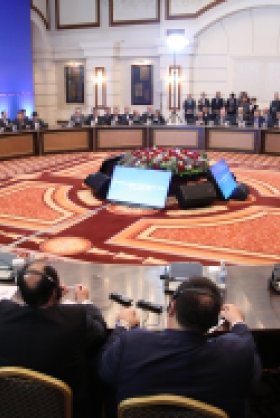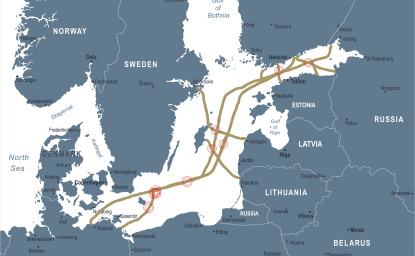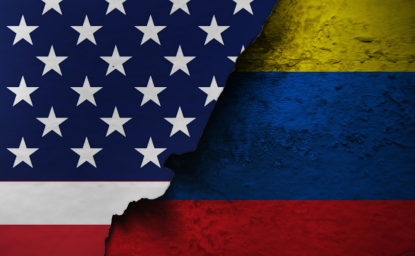Kennan Cable No.23: Putin’s Middle East Triangle


Introduction
The recent Russian-Iranian-Turkish de-escalation plan for Syria tells us more about Russia’s geopolitical vision for itself than about Syria’s prospects for peace. The agreement forged on May 4 in Astana, Kazakhstan, calls for the three powers to assist with maintaining a cease fire and delivering humanitarian assistance in four de-escalation zones. Turkish and Russian troops will patrol the areas, but UN assistance is “not needed.” This plan may be no more effective than previously acclaimed cease-fires and this agreement has its own loopholes: Russia won’t bomb in those areas as long as “rebels” cease fighting. The identity of “rebels” and whether they really cease fighting will be judged by Russia.[1]
But the aims which the agreement reveals show the political aspirations of the parties. By making these powers co-guarantors of the projected de-escalation, the plan shores up each country’s position within Syria and the region. Turkey staves off the Kurds and Iran continues to support fellow Shi’ites and the Assad regime. The big winner, despite the costs, is Moscow. Russia is not merely poised to reestablish power (political, commercial, and military) in the Middle East, but asserts itself as the preeminent world power in this region at the expense of the United States.
Russian and Soviet Aims in the Middle East
Russian outreach to the Middle East has been a recurring foreign policy pattern since Muscovy strove for access to the Black Sea in the late 17th century. In the 18th century, Peter the Great built a fleet just to fight the Ottomans there. Catherine the Great took its north coast, with Crimea, and acquired special rights for Orthodox Christians in the Ottoman-held Holy Land. Later, Russian competition against France and Britain for access to the eastern Mediterranean led to the Crimean War in the 1850s. The collapse of the Romanov Empire during WWI ended Russian hopes for control of the Straits, and Stalin’s effort to revive that imperial goal met the same frustration at the end of World War II.
Bolshevik rule altered Russia’s rhetoric but not its goals. Lenin and the intellectual core of the Bolshevik leadership expected global revolution— not a revolution confined merely to Russia with its tiny proletariat. Given the limited reach of industrialism in his time, Lenin lit on the idea that the populations of the “colonial and semi-colonial world” constituted a kind of global working class to the capitalist-industrial empires like the British. After the World War, Lenin thought emergent Turkey and Iran were especially ripe for Bolshevik appeals. The Red Army’s occupation of the Caucasus, starting with Azerbaijan in 1920, put Lenin’s regime on the doorstep of the Middle East.
Azerbaijan’s capital, the industrial city of Baku, was thus transformed in Bolshevik strategy from the “alarm bell” for labor unrest in the tsarist period to a “springboard for the revolution” to the colonial world. To showcase Baku as a model of Soviet rule in “the Muslim world,” the oil city hosted the Congress of the Toilers of the East in September 1920, when the Bolsheviks controlled only part of Azerbaijan. Throughout that decade, the communist regime made policies in Baku with an eye to the impressions they were making in neighboring Muslim areas, especially Turkey and Iran. The restoration of political stability in those countries in the mid-1920s led their leaders to reject Bolshevik overtures. Moscow did not reach out again for two decades, when the heavy hand of Stalin tried to grab territory from both Turkey and Iran after World War II. Only Stalin’s successors managed to approach the Middle East in a more congenial guise: not as a revolutionary beacon, but as a commercial partner and even as a “Muslim power” with millions of happy Muslims who had better electric power and more schools than neighboring Muslim states. Russian president Vladimir Putin has followed in the foots steps of both Peter the Great and Lenin and then went one better – he has forged commercial as well as military bonds with Iran and strengthened political relations with NATO-member Turkey, positioning Russia to be a bridge between the two as well as coordinator of policy in their neighborhood—specifically, in this decade, in Syria.
Putin’s Long Front in the West
Working quietly and consistently, Putin has reestablished Russian influence and even military presence in areas that tsars and commissars historically coveted. The Russian leader has spent a long time patiently building relations with Iran and Turkey through bilateral commercial deals, diplomacy, military cooperation, soft power such as tourism (to Turkey), and multi-lateral institutional bonds through the Shanghai Cooperation Organization (SCO). Russian-sponsored peace talks for Syria, starting early this year in Astana, Kazakhstan, followed a Russian-Syrian deal on the naval base at Tarsus and use of airbase near Latakia ensuring Russian presence there for next 49 years.[2]
There’s a pattern. Crimea (and thus Ukraine), the Straits (hence Turkey) and the eastern Mediterranean (Syria, Lebanon, Palestine) are, from the Russian perspective, one long front. Crimea is not part of a “Ukraine problem” as separate from the base at Latakia as part of a “Syria problem.” This long front extends northward to the Baltic and south to Suez. Only by looking at the map from this perspective, Moscow’s perspective, do the actions in these areas appear as parts of a single strategic policy that require a corresponding vision for analysis and response. By the same token, NATO-member Turkey, which breaks up that frontline of Russian expansion, has seemingly been softened as a bulwark of western influence by the newly cordial relations between Putin and Turkey’s increasingly authoritarian president, Recep Tayyip Erdoğan, who is chafing under Western criticism of recent political repressions. Putin needs this emerging partnership for his strategic plan in the West, just as Erdoğan needs Russian gas and tourists.
What is behind that long front? From the Baltic to the Crimea, the rear is Russia itself. The southern part of this front, however, is bordered on the east by countries that Russia must strive to manage and in which Putin has varying degrees of leverage. East of Turkey lie the former Soviet republics of the south Caucasus -- Georgia, Armenia and Azerbaijan. East of Syria is chaotic Iraq and regional power Iran. The relationships of these countries in the rear of Putin’s western front have enormous political, economic and strategic implications for Russia, the Middle East, and the world.
Caucasus in the Triangle
The states of the south Caucasus are situated at the center of the geopolitical triangle defined by Turkish- Russian-Iranian relations. But each of these three small states does not and cannot play the same role in this triangle. Armenia has a common border but no diplomatic relations with Turkey. Armenia borders Iran, with which it has a friendly relationship and trade, but has no common border with its political and economic ally Russia. And Yerevan is irked by Russian weapons sales to its enemy, Azerbaijan. Georgia is hostile toward Russia, which instigates separatist minorities along their common border in the restive Caucasus Mountains. But Tbilisi maintains cordial ties to its neighbor Turkey, a commercial partner and popular destination for Georgian tourists. Georgia has no common border with Iran but enjoys growing trade and Iranian investment in several key areas including energy and agriculture.
Oil/gas-rich Azerbaijan, in contrast, is the only state that borders Russia, Iran and Turkey, the latter for a 20-mile stretch in the exclave of Nakhjivan. It has diplomatic and commercial relations with all three of these neighbors and Georgia. The vital Baku-Tbilisi-Ceyhan oil export pipeline carries Baku oil to the Mediterranean at Ceyhan in Turkey, less than 200 miles north of the Russian naval base at Tarsus.[3] A natural gas pipeline from Baku through Turkey to Europe is under construction and dovetails with Russian-Turkish gas deals.[4] Finally, Azerbaijan is poised to be the final link in an overland corridor between Iran and Russia. Baku is becoming a major hub in the trilateral relations of its powerful neighbors.
Azerbaijani President Ilham Aliyev moves easily between at least two of these neighbors. Aside from his excellent command of English, his Russian is fluent and Azerbaijani is so close to Turkish as to be mutually intelligible. Relations with Iran are generally correct if not always cordial, especially under Rouhani. Despite Azerbaijan’s majority Shi’a population, contentious issues irritate Iranian- Azerbaijani relations including Baku’s relationship with Israel, Azerbaijan’s secularism, and Tehran’s fear that Azerbaijan as an independent state will attract Iranian Azerbaijanis who chafe under cultural pressures of the state and Persian majority. Nonetheless, Azerbaijan’s location and energy resources make it a major player in the region despite its sham elections, human rights violations, and rampant corruption.
The Southern Front
Certainly the weakest leg of this triangle is Turkish- Iranian relations. The two are adversaries who have competed for territory and resources for centuries. Iran’s adoption of Shi’ism as the state religion around 1501 added a sectarian component to their mutual enmity. There are currently grounds for rapprochement. The main common interest for present rulers in Ankara and Tehran is keeping the Kurds down. This imperative has led to some Turkish acquiescence on Iran’s role in Iraq, exemplified by Turkish Prime Minister Binali Yildirim’s February visit to Baghdad to get support for keeping the PKK out of Iraq’s northern Sinjar region.[5] Ankara may drop objections to keeping Assad in Damascus to get a free hand against Syrian Kurds, and the early May Astana agreement codifies that trade-off.
Other issues, particularly in Syria, continue to block Turkish-Iranian cooperation. Competing projects for gas pipelines through Syria will benefit only one of these states. One pipeline would run from Qatar through Saudi Arabia and Turkey to Bulgaria. The other would begin in Iran and transit Iraq and Syria then, skirting Turkey, would run under the Mediterranean to Greece.[6] Both projects need Syria. Either one of these, or any new gas pipeline for that matter, stands to reduce European dependence on Russian gas and thus undermines Gazprom earnings and Moscow’s leverage in Europe. As long as Syria is mired in civil war, no construction can take place. The Astana plan, with its exception to respond to “rebel action,” gives the guarantor state a perpetual license to bomb any zone.[7] Russia has already done so in previous cease fires. And should peace break out on the basis of these zones, the competition of the guarantors on the ground may perpetually delay construction, also to Russia’s benefit. Thus all gas pipeline plans involving Syria remain a pipedream.
North South Transit Corridor (NSTC)
In contrast, the North-South Transit Corridor (NSTC) is already a reality. It will soon link Iranian and Russian rail systems through Azerbaijan, the only state bordering both nations. The land route will rival, and perhaps shift trade away from, the maritime trade route through the Suez Canal with economic, political and military repercussions around the globe.
The concept for this overland transit corridor goes back at least to 2002. Development moved ahead mostly below the international radar as Iran extended its domestic north-south rail line which ran from Bandar-i Abbas, a major Iranian port on the Persian Gulf, north to Qazvin. The project got a very public boost with an August 2016 meeting in Baku of presidents Putin, Aliyev, and Iran’s Hassan Rouhani. By January 2017, the Iranian extension of the rail line northward from Qazvin to Rasht near the Azerbaijani border was 90 percent complete.
Azerbaijan, Iran, and Russia are three oil/gas-producing countries who have been hurt by the drop in oil prices. The two larger states are both objects of Western sanctions, and Azerbaijan is potentially a target of the Global Magnitsky Act. All three are regularly criticized by Western organizations and states for human rights violations and failures of democratic process in elections, legislature, and judiciary. The three presidents are banding together in this financial and political deal overtly for trade and “security,” a cover for quashing domestic unrest and rebuffing foreign critics. Other aims are likely military and intelligence cooperation.
Russia and Azerbaijan have, in the last year, pledged an unspecified amount of financing[8] for the completion of the last crucial rail link between Astara, Azerbaijan and Rasht, Iran. The 140-km of track is scheduled to be completed during 2017, potentially shifting millions of tons of trade away from the maritime routes. Cargo, possibly including military, via the NSTC is projected to reach 6 million tons per year at opening and 15-20 million tons per year in the future.[9] Smuggling becomes easier as well. Passenger traffic raises security challenges given the proximity of such terrorist groups as the Islamic State.
The Win-Win-Win Deal
The NSTC is a win-win-win deal. It helps Iran break out of its international isolation imposed mainly by the US since the hostage-taking of 1979 Islamic Revolution. Iran will be able to link its domestic railway to Russia’s and also connect its port of Bandar-i Abbas, which receives substantial trade from India. With the new rail connection, Iran stands to capture an even larger share of trade from India that presently transits to Europe via the maritime route. The expanded volume of trade, together with the demands of maintaining the rail system, will generate revenue for Iran and may contribute to Rouhani’s pledge to create non-oil jobs for Iran’s young population. These steps will enable Tehran to project a stronger image in economic and soft power to constituents from the eastern Mediterranean to central and south Asia. Moreover, this project has a mirror image in eastern Iran with the under-construction rail lines from the port of Chabahar (another destination for south Asian goods) north to Zahedan on border with Pakistan and Afghanistan. The next step may be north to Turkmenistan. Meanwhile, China is developing Pakistan’s Gwadar port as part of its China-Pakistan Economic Corridor (CPEC) meant to avoid shipping Middle Eastern oil to Asia through the Straits of Malacca.[10] Iran gains with either one of these projects, and even more so if both are completed. In time, US sanctions may become only a minor annoyance.
Azerbaijan has been planning to become a transit hub since the 1990s. Discussions of this vision have focused on east-west transit trade linking Central Asia and perhaps China to the Middle East and Europe through Turkey. That idea does not, of course, preclude the north-south corridor that is nearing completion. The drop in oil prices of 2014 hit Azerbaijan hard with catastrophic loss of income, despite claims to the contrary (Azerbaijan’s currency the manat has been devalued three times since early 2015, most recently last January). The NSTC will not only bring in millions, but unlike diversification of the economy with local manufacturing, will concentrate this income flow at the top of government, benefitting the oligarchs who are deeply involved in construction and transportation sectors. This in turn strengthens the Aliyev family’s hold on power.[11]
Azerbaijan has reached out to other potential partners for NSTC trade. In January, Aliyev’s government signed an agreement with the Islamic Development Bank in Saudi Arabia to expand Islamic practices of lending in Azerbaijan.[12] And the Saudis are interested in the NSTC. Apparently, they are willing to hold their noses and trade with or through Iran via Bandar-i Abbas.
Russia: The Biggest Winner
Russia stands to gain not only from the NSTC, but also from its commercial and military relations with all its partners in the triangle and in the Caucasus. First the NSTC: Putin has said the new overland corridor would be an alternate (shorter, cheaper) trade route for goods from Asia to Europe. Russia can therefore tax goods going west and might make additional deals to send trade eastward, boosting commerce, and thus political bonds, with Central Asia and China. Moreover, Russian control over one stream of trade into Europe, like the flow of gas, may give Moscow leverage, albeit marginal, over Western countries.
Iran has been a key partner in Russia’s projection of power into the Middle East, permitting Russia use of its bases and transit through its air space. After resolving the crisis of the shoot-down of one stray Russian plane in Turkish airspace last year, Ankara has made its peace with Russian military presence in warships off its coast on the way to their Syrian base. These partnerships and the agreement on Syria give Russia greater access to returning Chechen jihadis whose influence could threaten Russia control in the Caucasus.
Is Russia truly a big winner in Syria after its own bombers have reduced to rubble infrastructure and entire sections of major cities like Aleppo? If Russia under Putin wants to “save” Syria as well as Assad’s regime and make it a viable and grateful client, then such destruction works against that goal. But if Putin wants to show that he controls the ground game in this strategic area, that Russia and not the United States is the most important power in the eastern Mediterranean, then the destruction only enhances his position there and his image. The use of overwhelming force is part of Russian military doctrine, as demonstrated against “radicals” in Grozny, Chechnya. Moreover, a Russian victory here can be spun as a victory for Russian “values” of stability and a defeat for Western values of democracy and human rights, which authoritarians claim is destabilizing and intrusive. The new US leadership has conceded the latter. With Western influence and traditional principles undercut, the greatest losers are the people in the conflict zone who hope for an end to repression.
Endnotes:
1 Thanks to Henri Barkey, Sarah Chayes, and Rajan Menon for their comments on an earlier draft of this article.
2 Rod Nordland, “Russia Signs Deal for Syria Bases’ Turkey Appears to Accept Assad,” NYT Jan 20, 2017, https://www.nytimes.com/2017/01/20/ world/middleeast/russia-turkey-syria-deal. html?action=click&contentCollection=Middle%20
3 Michael Peck, “How Russia Is Turning Syria into a Major Naval Base for Nuclear Warships (and Israel Is Worried),”
The National Interest, March 18, 2017; http:// nationalinterest.org/blog/the-buzz/how-russia-turning-syria-major-naval-base-nuclear-warships-19813
4 The Trans-Anatolian pipeline or TANAP will be an extension of the existing South Caucasus Pipeline (SCP) that now carries gas from Baku to Erzurum; it is expected to be complete in late 2018 and to carry gas to western Turkey and Europe in 2020. See http://www.bp.com/en_ge/bp-georgia/about-bp/bp-in-georgia/south-caucasus-pipeline-- scp-.html for details.
5 Baraa Sabri, “Saudi and Iranian Rapprochement in the Face of Russia and Turkey,” Feb 15 2017, http://www. washingtoninstitute.org/fikraforum/view/saudi-and-iranian-rapprochement-in-the-face-of-the-russia-and-turkey
6 Charis Chang, “Is the fight over a gas pipelines fueling the world’s bloodiest Conflict,” Dec 2, 2015; http://www.news. com.au/world/middle-east/is-the-fight-over-a-gas-pipeline-fuelling-the-worlds-bloodiest-conflict/news-story/74efcba95 54c10bd35e280b63a9afb74
7 The terms are similar to the 1939 Molotov-Ribbentrop Pact that protected Estonia as long as it remained neutral but left the definition of that neutrality up to Moscow.
8 Azertac January 7, 2017; “Russia ready to finance Rasht- Astara railway construction,” 26, November 2016, (http:// realiran.org/russia-ready-to-finance-rasht-astara-railway-construction/)
9 In 2007, 7,700 container ships carried over 318,000 tons of cargo through the Suez Canal noted a World Shipping Council Report (http://www.worldshipping.org/ pdf/suez-canal-presentation.pdf). A 2017 report (Luke Graham, “Cargo ships could save thousands by skipping the Suez Canal,” CNBA 26 Feb 2017; http://www.cnbc. com/2016/02/26/cargo-ships-could-save-thousands-by-skipping-the-suez-canal.html) noted that with falling oil prices, some ships avoid the costly canal fees and use the longer route around Africa.
10 On the Chabahar port project and Modi visit to Iran May 2016 – Diplomat article (July 11, 2016, by Kabir Taneja)
11 Amina Nazali, “Iran minister says joint transport projects to bring multiple benefits,” January 18, 2017, http://today.az/ news/business/157826.html
12 Nigar Abbasova (Today.az), “Azerbaijan, IDB signed grant agreement…” January 18, 2017, http://today.az/news/business/157828.
The opinions expressed in this article are those solely of the author.
Author

Professor of History, University of Massachusetts, Amherst

Kennan Institute
After more than 50 years as a vital part of the Wilson Center legacy, the Kennan Institute has become an independent think tank. You can find the current website for the Kennan Institute at kennaninstitute.org. Please look for future announcements about partnership activities between the Wilson Center and the Kennan Institute at Wilson Center Press Room. The Kennan Institute is the premier US center for advanced research on Eurasia and the oldest and largest regional program at the Woodrow Wilson International Center for Scholars. The Kennan Institute is committed to improving American understanding of Russia, Ukraine, Central Asia, the South Caucasus, and the surrounding region through research and exchange. Read more

Explore More
Browse Insights & Analysis
The OSCE is a Good Value for America


